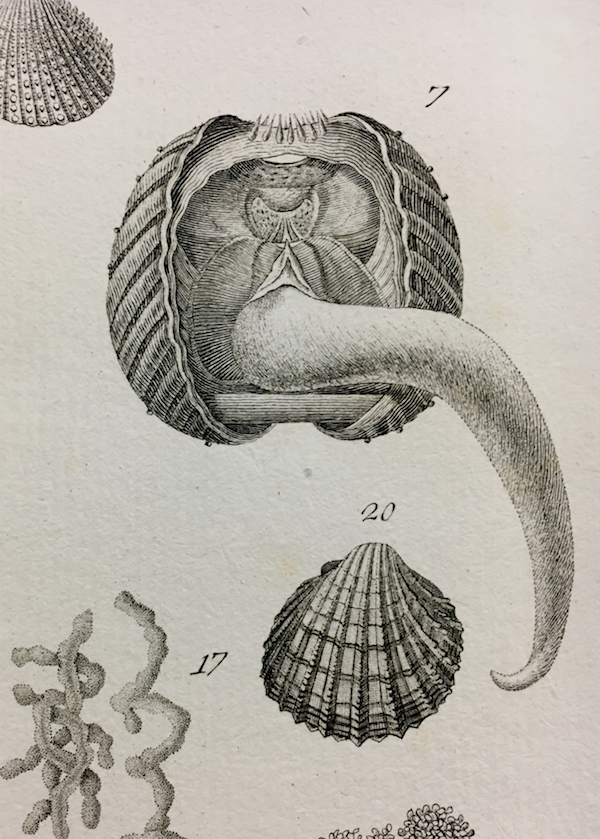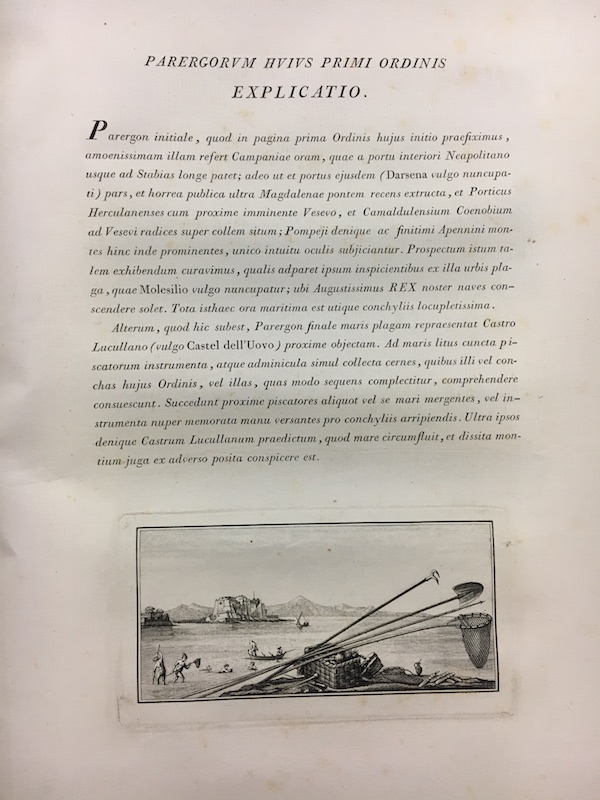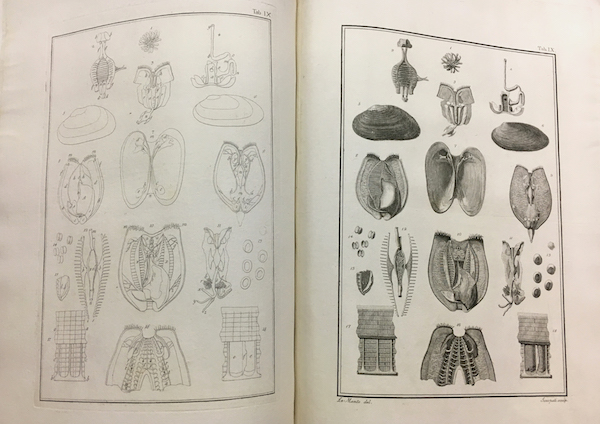
Testacea Vtrivsqve Siciliae Eorvmque Historia et Anatome Tabvlis Aeneis Illvstrata a Iosepho Xaverio Poli. Poli, Giuseppe Saverio. Parmae: Ex regio typographeio, 1791.
***Z233.B6 P76. A very suggestive detail of one of the many quite bodily intaglio reproductions found at the final pages of Poli Testacea Vtrivsqve Sicicliae, 1791-1827.

Testacea Vtrivsqve Siciliae Eorvmque Historia et Anatome Tabvlis Aeneis Illvstrata a Iosepho Xaverio Poli. Poli, Giuseppe Saverio. Parmae: Ex regio typographeio, 1791.
***Z233.B6 P76. Full page introduction to a chapter on the "first order of study" with plate showing a net, shovel, and spear – presumably with which the humans in this image are using as they swim, dive, and sail around the coastline catching shells & mollusks. Click image for detail.

Testacea Vtrivsqve Siciliae Eorvmque Historia et Anatome Tabvlis Aeneis Illvstrata a Iosepho Xaverio Poli. Poli, Giuseppe Saverio. Parmae: Ex regio typographeio, 1791.
***Z233.B6 P76. An entire page worth of almost gruesome and somewhat sexy mollusca. This spread depicts both the identification of parts, numbered to correspond to an explanation later in the book which describes each organ (left), and a detailed rendering (right) of multiple shell & mollusk varieties.
Poli Testacea Vtrivsqve Sicicliae, 1791
Colloquially: seashell; in the 18th century Latin: testacea.
Shells and mollusca are strange, sometimes supple, creatures with a most intriguing visual representation in their histories of scientific study. As reproduction techniques and technologies transformed alongside those for image production, there have been incredible leaps in the recording of biological preoccupations.1 And with Giuseppe Saverio Poli and S. Delle Chiaie’s Testacea, conchology seems to have had an incredible headstart on capturing the sensuous detail of mollusc life forms.
In an enormous volume measuring approximately 2.5” thick by 14” wide and 20” tall, Testacea contains over three dozen illustrated plates, a decorated preface and smaller illustrative introductions to its chapters on learning the practices of conchology: the study of shells.
The first of two volumes2, Testacea, was printed and bound in Reggio, Italy for the Royal Society of London's University of Sciences at Turin. This copy is now located within the special collections on campus at the University of California, Los Angeles. Between its slightly stained, un-dyed and un-tanned leather covers, are pages of hand set type explaining the practice of conchology for students of the sciences in 1791, London. An excerpt from Giannettasius Halieut (who may have been a writer, poet, potentially also scientist) is printed on the title page verso:
“My slope with the green and fragrant herbs;
Shores dyed puple by Shells
Inviting . . .
Olympians themsleves, and both Dicarchides and
Pithecusae keep their heads high, Divine,
hastily I point the way towards crystal waves,
Glittering crystal, the roof hanging above the swelling of the
Sea . . . ”
With practically all of the text unreadable to someone untrained in Latin language, the most exciting part of this oversized tome lay between the final 50, or so, pages. There, a total of thirty-six intaglio illustrations are printed in pairs. Each spread shows an explanatory line drawing (verso) of the specimen which is drawn in the same spot as an illustration rendered with artistic detail on the opposite (recto). Some spreads show the kinds of tools and technologies used by conchologists of the time but most show off the shells and their inhabitants.
Due to the widening of scientific scholarship during the late 18th century, one can imagine this book being one of the first of its kind.3 By the 19th century, a distinction between the study of life inside the shell (malacology) and the shell itself (conchology) was made.4 Often, the two studies are seen as one in the same.
At the time it was written, Poli Testacea, was following suit in the way which most scientific studies presented the practice of collecting, examinating, representing, and identificating specimens from field study. These taxonomic plates focus on the life inside in a most graphic way, one that may be interpreted as a highly sexualized version of the molluscan life form. The images on the left show how the engraver has rendered the very specific and strange beauty of fleshy animals who make homes inside the protective armor of a shell. Not unlike the explanation William Louis Stern presented on the “uses” of early botanist books within the Clark Library, these etchings appear quite obviously bodily - as if they could be used to study female sex organs, in addition to mollusca.5 The big difference, of conchology against botany, being that all animals are sexual by nature while the illustrative studies of plant life were manipulated to appear as if they were.
Most noteably, this text and its illustrations give insight to the enormous amount of labor required to study something with parts smaller than the eye can see and the dedication and devotion scholars of the 18th and 19th centuries had for compiling their work into print with intentions to continue the production and spread of knowledge on what may seem, now in the 21st century, as some of the most trivial of topics – like the study of shells.
Notes
1 Bailey-Matthews Shell Museum, Bailey-Matthews Shell Museum, Inc American Malacologists, and Delaware Museum of Natural History. The Nautilus. Vol. v.102 (1988). Melbourne, Australia.: American Malacologists, 1988. page 8, vol.102, no. 1. https://www.biodiversitylibrary.org/item/34231. Accessed March 16, 2018.: Most of the photos on this page are “light micrographs” taken using an SEM, scanning electron microscrope at the National Museum of the United States (USNM). ↩
2 Poli, Giuseppe Saverio, and S. (Stefano) Delle Chiaie. Testacea utriusque siciliae eorumque historia et anatome tabulis aeneis illustrata. Parmae : Ex regio typographeio, 1791. http://archive.org/details/TestaceautriusqIIPoli. Accessed March 2, 2018. A digitial copy on archive.org of the second volume to this original text from the Royal Society of London on conchology. ↩
3 “History of Science | Definition, Natural Philosophy, & Development of Science - The Rise of Modern Science.” Encyclopedia Britannica. https://www.britannica.com/science/history-of-science/The-rise-of-modern-science. Accessed March 1, 2018. This article provides insight to the importance and transformation of scientific study at the end of the 18th century. ↩
4 Tunnell, John Wesley. Encyclopedia of Texas Seashells: Identification, Ecology, Distribution, and History Texas A&M University Press, 2010. An historical description of conchology and its practices as well as the explanation of similarities of the two studies, malacology and conchology. ↩
5"Botany, with Special Reference to the 18th Century.” Taxon 42, no. 4 (1993): 773–79. https://doi.org/10.2307/1223262. Accessed March 1, 2018. Deptuy Curator of Botany at the Smithsonian's Museum of Natural History discusses the use of books on botany (for practices other than scientific study) at a symposium hosted by The Clark Library in 1991. ↩
This spotlight exhibit by L. Molina as part of Dr. Johanna Drucker's "History of the Book and Literacy Technologies" seminar in Winter 2018 in the Information Studies Department at UCLA.
For documentation on this project, personnel, technical information, see Documentation. For contact email: drucker AT gseis.ucla.edu.